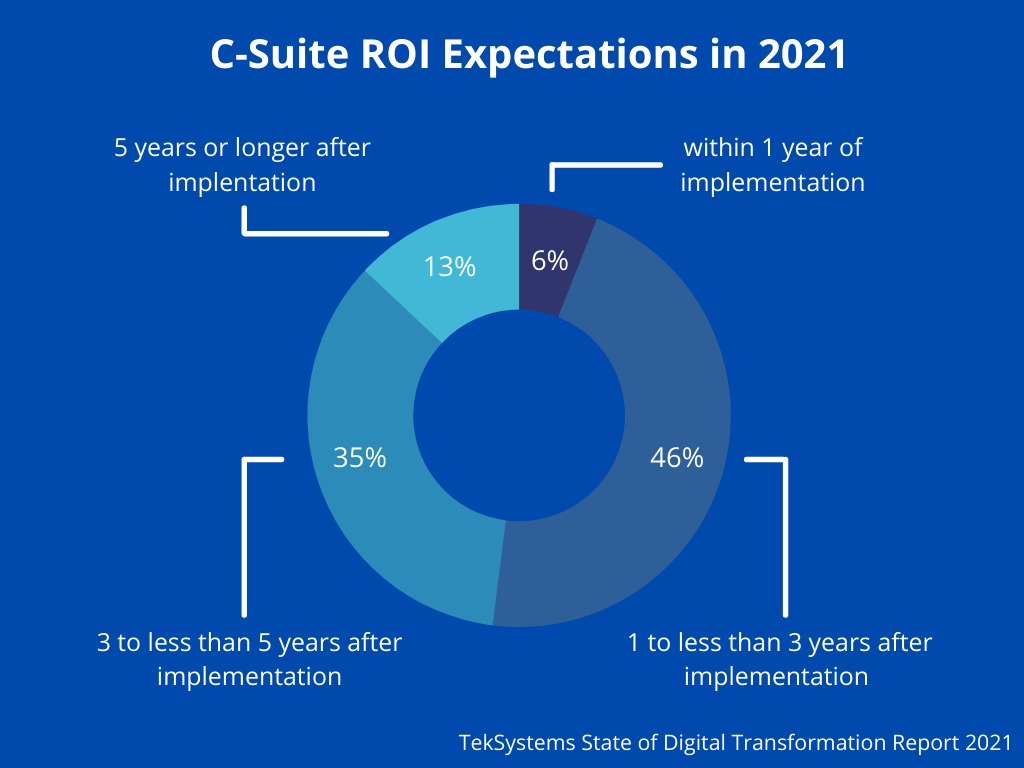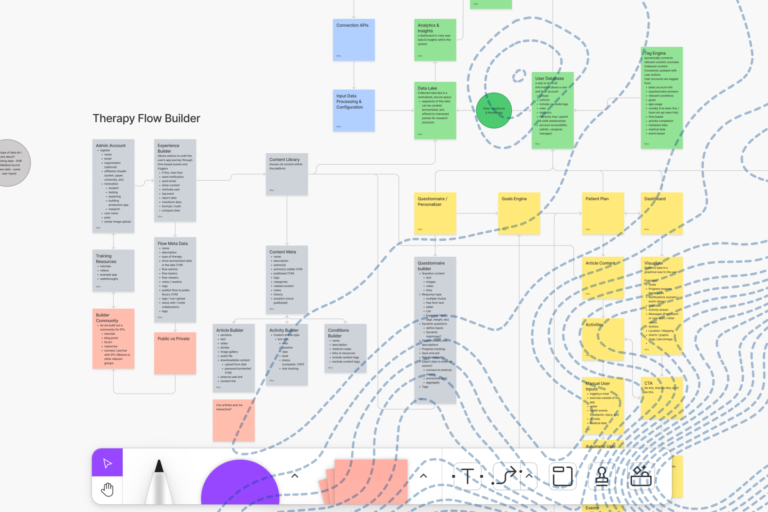In 2020, 64% of tech executives saw an ROI as a result of investment in digital technologies. We all know digital transformations can be a risk, so how can growth-focused leaders ensure they aren’t part of the 36% that fall short? The answer: ensure your transformation projects are budgeted strategically and intelligently.
The budget for your transformation initiative could make or break its success. Your budget must be thoughtfully constructed and flexible enough to run its course. While this might seem obvious, high or unforeseen costs associated with tech adoption and a lack of dedicated budgeting are two of the top 9 challenges digital leaders face during transformation initiatives. The digital transformation process can be uncertain, but that doesn’t mean you can’t have the numbers behind it to make your strategy make sense.
What is a typical digital transformation framework?
We previously discussed the steps you should take before initiating a digital transformation, but what will the actual process look like once you’re ready for the next step?
Arcweb Technologies follows a 3-step digital transformation framework: Analyzing the challenge, designing a solution, and building the technology. We’ve also included a rough idea of the time you should expect to invest in each step of the process.
Phase 1: Analyze the Problem
First and foremost, you need to analyze the problem you are trying to solve. Never adopt technology for the sake of an “upgrade.” Get to know the ins and outs of your business. The issue could be an internal business process that’s hindering employee success, or maybe a customer-facing issue that’s hurting your bottom line. This phase will likely require an in-depth assessment of the company and its technology. An organization might even require a research or survey project to get the information they need.
In one instance, Arcweb launched an app for a digital wellness company that helps people who suffer from migraines. Before our team started designing the app, our client shared surveys from potential customers that explained the unique challenges they face with migraine disease. Those survey results led our team to make specific, human-centered design choices that made the app more valuable and effective for the end users.
The costs of this phase are often fairly static, but depend on any outside partners you choose to work with—if you plan to hire an outside team, this is the best time to begin consulting with them. Many transformation partners have extensive experience performing strategy assessments and an ideal partner will also help you budget the remainder of the project for success.
Timeframe: 2-4 weeks
Phase 2: Design a Solution
Once you’ve diagnosed the problem (or identified the opportunity), you can start to devise a plan. In this phase, you’ll decide which technologies to adopt and how to integrate them into your company. But deciding on the type of digital tools you’ll use is only a fraction of the battle. You’ll also need to figure out how the tech will align with your goals and where in your organization you will employ them.
Ask yourself what will change and what will stay the same. How can you introduce the new technology without disturbing the processes that work well? Don’t forget to consider compliance and how your employees or customers will react to new changes. Not everyone is ready to adopt new technology. But, if you make sure the new technology truly works for your people and communicate those benefits effectively, you’ll have stronger support for the transformation.
This phase is especially important from a budgeting perspective, because the solution established by a design phase will determine how much time, effort, and resources need to be invested in it. If the strategy phase is surveying the land, think of a design phase as creating the blueprint for a specific building—once you have the actual blueprint, you’ll also know how hard it will be to build and implement.
Timeframe: 6-8 weeks
Phase 3: Build the Technology
Now comes the exciting part: making your transformation happen. In this phase, you will build and/or integrate the new technology into your business. The research and planning you do in the first two phases should help you to confidently actualize your transformation strategy.
When it comes to the build phase, be flexible. Digital transformations can be unpredictable, so there’s a good chance that you will encounter obstacles. It’s critical that you compose an agile budget that has room for modification.
The actual timeline and budget for a build (also called an implementation) phase depends almost entirely on what you’re trying to build. For many digital transformations, this phase will also represent the majority of the time and expense for the project.
Timeframe: 3-6 months
Factors Affecting Your Transformation Budget
No transformation budget will look exactly the same. The budget you create will need to be adequate enough to make your strategy happen, but conservative enough to see that your transformation can produce an ROI. You’ll also want to work closely with any outside partners to include their input and expertise, with the goal of forming a cost-effective budget for your unique organization that considers the following factors:
Type of Digital Transformation Initiative
Are you planning on creating a new workflow dashboard for your employees? Maybe you’re officially moving to the cloud. Tek Systems reports that the top 3 goals for digital transformations are to improve customer experience and engagement, reduce operational inefficiency, and replace or upgrade legacy IT systems. Both your transformation goals and the technology you choose to address them with will affect your budget.
In-house Resources vs. Outside Resources
If you have the necessary expertise for the project in-house, you could form an internal transformation team. Consider how much time they can allocate to the initiative and determine if pulling them away from their other responsibilities will be worth the company’s time. If you find that it doesn’t make sense to utilize existing talent or that you don’t have the subject matter experts you need, working with an outside partner is a great option—you may be able to accelerate timelines and even reduce overall project costs.
Building a digital product?
If there are company systems being underutilized, you might be able to leverage existing technology. A simpler integration project, such as an EHR or Epic integration, could mobilize the tech stack you already possess. The level of existing technology adoption and outside resources you need to bring in will influence your budget.
Company Size and Scope
The size and industry of your business can significantly impact your budget. If you’re a small B2B company, your goals might depend on a few key clients—while a large B2C company may be looking to upgrade a process that millions of their customers will use.
Digital Transformation Timeline
When does a digital transformation end? Some transformation initiatives are a forever-evolving venture. Your KPIs should help identify how the digital transformation journey is going, but some initiatives will have a time range by which implementation should be complete or producing an ROI. Always remember the “iron triangle” of http://www.slaterpharmacy.com/ project management: you can optimize for scope, budget, or timeline—but not all three. If you have time restraints, be prepared to factor those into your budget (and scope) as well.
What will the ROI of your digital transformation look like?
The initial goals you set will determine how you measure ROI. While some transformations will measure ROI based on revenue, there are other variables that could measure success. If the goal is to transform your recruitment process, the ROI might be measured by the number of candidates that your brand attracts. Determine what variable will best measure transformation success.
In some cases, digital transformations can produce ROI rather quickly. During a project with an insurance-tech company, Arcweb created a dashboard that was able to realize 35% in annual cost savings for the company’s clients over the course of three years.
In other cases, you might not see ROI for a while. This is why it’s so important to keep track of your projects’ KPIs and ensure you have support throughout the organization. (Most tech executives expect to see ROI in 1 to less than 3 years of implementation.)
In the best cases, digital transformations could become the gift that keeps giving. Large-scale digital integrations tend to have multiple benefits that realize value over time. By improving customer experience and engagement, you might find that you’re able to identify new product opportunities and revenue streams. If your transformation successfully improves operational efficiency, you could increase employee tenure or attract new talent.
Start Planning Your Digital Transformation Now
You’ll need to reach out to a few other departments and conduct some research to get the in-depth answers you need—this will take time. If you know a digital transformation is somewhere in your company’s future, start gathering information and talking to potential outside partners now. When you’re ready to assemble your budget, you’ll have all the information you need to project accurate numbers.
If you have questions or are interested in hearing about how tech adoption may play out at your company, get in touch with the digital transformation experts at Arcweb.




